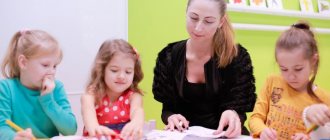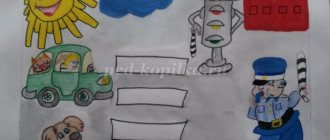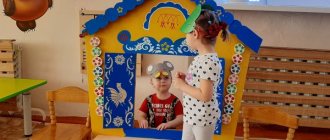Basic knowledge and skills at 4 years old
What a child should be able to do at four years old - basic knowledge and skills:
- good control of your body: confidently move and navigate in space;
- be able to count to five and know what numbers up to five look like;
- it is enough to speak well: speech should become clearer compared to the age of three;
- possess self-service skills;
- understand some social norms: for example, distinguish good actions from bad ones.
Sensory development and dental care
vision almost as as that of adults. Four-year-olds are rarely ready to read, but you can already introduce letters to your child. The main thing is to choose books, cards and other aids where the letters are printed in large font - this way the child’s vision will not be too strained.
hearing is already fully formed. The sense of smell is improved : the child feels and identifies complex odors. The skin remains sensitive to cold; the baby feels warmth in the same way as adults. Children aged four years feel the taste of food almost like adults, but with a slight difference: in a multi-component dish, the child mainly distinguishes the main component, poorly recognizing the nuances of taste of the remaining components.
Four-year-old children already have 16-20 baby teeth . Due to the fact that baby teeth are much more vulnerable than permanent teeth, you need to carefully monitor your child’s oral hygiene: teach your child to brush his teeth regularly and treat problem teeth in a timely manner. Keeping baby teeth healthy is very important: baby teeth removed early can cause improper jaw formation and lead to other problems. Thus, children who have lost their baby teeth early may have distorted facial features.
Norms of physical development
Between three and four years of age, a child does not grow as quickly as at an earlier age. But the acquired physical and motor skills are sharpened, and new ones appear. At the age of four, differences in the physical abilities of boys and girls become noticeable.
Differences between boys and girls
Although the weight and height of four-year-old children of different sexes are still the same on average, the difference in physical development is already clearly visible:
- Boys at 4 years old run faster, outperform their peers in outdoor games, and learn to ride a bicycle well earlier.
- Girls at the age of four are ahead of their peers in intellectual development: they construct complex sentences, solve logical problems correctly, and easily memorize poetry.
Researchers who studied the thinking characteristics of preschool children found that this difference in development between boys and girls is associated with the structure of the brain. Four-year-old girls have a well-developed left hemisphere of the brain, which is responsible for developed intelligence and fluent speech.
With age, intellectual differences between children of different sexes are erased, and physical differences become even more noticeable.
Weight and height
The average height of children at four years old is 102-103 centimeters. Average weight - 16-18 kilograms. There may be deviations up or down from the average height and weight, depending on hereditary factors and the lifestyle of a particular child.
If your baby's height at 4 years is less than 94 centimeters, or he weighs less than 12 or more than 25 kilograms, it may be worth changing his daily routine and diet after consulting a pediatrician.
The norm of weight and height specifically for your son or daughter can be calculated as follows: in the interval between three and four years, the child should grow by 6-7 centimeters, and the weight should increase by 1-3 kilograms.
Physical skills
Physical skills that most 4-year-olds master:
- confidently handle a tricycle or scooter;
- eat completely independently, using cutlery deftly and as intended;
- know how to handle small parts of objects: correctly form multi-level pyramids, assemble construction sets and puzzles according to instructions or with the help of an adult.
Psychological condition
Four-year-old children do not feel fear well - the task of parents is to tell their son or daughter about possible dangers: about potentially dangerous household appliances, about stray animals, about walking alone.
Normally, a psychologically developed child at the age of four should:
- take into account the assessment of your behavior by significant adults: parents, educators;
- be as independent as possible;
- be able to serve yourself in accordance with your age.
Content:
- Basic knowledge and skills at 4 years old
- Norms of physical development Differences between boys and girls
- Weight and height
- Physical skills
- What if the child does not speak or speaks poorly?
Motor skills
The coordination of a four-year-old child is developing better and better, acquired motor skills are consolidated and new ones appear:
- knows how to jump high and far, knows how to somersault;
- tries to hit the target with the ball, catches and holds the ball with both hands;
- standing on one leg, maintains balance for at least 10 seconds, makes several jumps on one leg;
- becomes quite flexible, easily tilting the body from a standing or sitting position, for example, in order to put on shoes;
- can walk on tiptoes;
- Dresses and undresses without adult help, or with little help if you need to cope with a difficult fastener or laces.
Cognitive development
At 4 years old, the baby strives to do a lot on his own, thanks to which his cognitive abilities develop intensively. The abilities of children attending a kindergarten or other preschool institution usually develop a little faster than those of children at home - communication with peers and regular classes with teachers have a positive effect on the formation of basic cognitive abilities: memory, attention, thinking.
Fine motor skills
The development of a baby’s speech and the correct development of thinking and memory depend on well-developed fine motor skills. It’s good if by the age of four the child has the following fine motor skills:
- colors pictures without going beyond the outline;
- tries to keep the pencil straight when drawing dots, does not lift his hand from the sheet of paper;
- traces samples and stencils with a pencil;
- launches the spinning top;
- folds his fingers, showing shapes, for example, “flashlight”;
- laces his own shoes or at least tries to manage the laces;
- strings buttons or beads with large holes onto a thread;
- Cuts out paper shapes with scissors fairly smoothly.
If your child does not yet master each of these skills, it is easy to help him: together learn to tie shoelaces, play with beads, show how to make finger figures.
Speech of a child at 4 years old
The passive vocabulary of a 4-year-old child is 3,000 words: this includes those words that the baby actively uses in speech, and those whose meaning he knows, but rarely uses in speech. Passive vocabulary includes, for example, outdated words that are often found in fairy tales: plow, upper room, stupa and the like.
A four-year-old’s active vocabulary includes as many words as he needs to communicate with others—usually about 1,000 words.
What if the child does not speak or speaks poorly?
A child at the age of four can coherently tell how the day went, uses sentences of eight words or longer in speech, and clearly describes the objects he saw.
Speech development in four-year-old children may differ - girls usually speak quickly, while boys find it more difficult to find the right words. But if the child does not speak at all or severely distorts words, you should consult a pediatrician.
The absence of coherent speech at 4 years old may indicate delayed mental development, hearing problems, and severe stress. A pediatric neurologist, otolaryngologist and speech therapist will help parents understand the reason for the child’s silence.
Second language learning
Courses for studying English or another foreign language suggest starting to learn a second language at the age of four. At this age, children easily remember foreign names of objects and phenomena and are not shy about making mistakes.
But it is advisable that the child already has a fairly good command of Russian speech before starting to learn a second language - otherwise serious problems with the pronunciation of foreign words are inevitable, which will be difficult to correct later.
Socialization: communication, emotions
At 4 years old, the child knows and accepts the norms of behavior in society. In communicating with peers, a four-year-old learns to share, play his role in the game, and recognize good and bad deeds. The child increasingly strives to communicate with peers, gradually separating from his parents. True, there are exceptions: when the baby does not want to play with other children and is more interested in spending time alone. This behavior is a variant of the norm and indicates the child’s character traits.
When communicating with adults, a well-socialized 4-year-old child follows the rules of etiquette: addresses himself as “you” and by his first name and patronymic, and follows the rules of behavior in kindergarten or other institutions. By the age of four, a child should know that he can only trust familiar adults, and that he should not talk to strangers or go somewhere.
The range of emotions of four-year-old children is quite wide: they are able to recognize the emotions of other people, restrain their own emotions, and actively use facial expressions and gestures to express feelings.
A four-year-old needs his own space - this could be a separate room or a play corner - where he feels like he is the master. A child may perceive an invasion of personal space without permission, even from close people, as painful.





